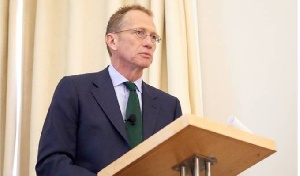- Home - News
- TWI News | TV
- Polls
- Year In Review
- News Archive
- Crime & Punishment
- Politics
- Regional
- Editorial
- Health
- Ghanaians Abroad
- Tabloid
- Africa
- Religion
- Election 2020
- Coronavirus
- News Videos | TV
- Photo Archives
- News Headlines
- Press Release
Business News of Wednesday, 22 April 2015
Source: B&FT
‘Africa’s infrastructure deficit exceeds US$90bn per annum’
Sub-Saharan Africa’s infrastructure lags well behind that of other developing countries -- and the gap continues to widen, exceeding US$90-billion per year over the coming decade, the latest in a series of white papers sponsored by commodities trading company Trafigura has shown.
The differences, the white paper indicates, are particularly large for electricity access, paved-road density, and access to water and sanitation.
Energy sector infrastructure, the report said, has particularly large-scale network effects and has the most powerful impact on output and productivity of all the sub-sectors.
“For example, water is often distributed by electric pumps. Natural energy products seem to exert especially significant effects at all stages of development.”
Titled “Foundations for Growth: Infrastructure Investment in Emerging Markets,” the white paper was written by independent economist Llewellyn Consulting, and it looks at how investment in infrastructure is of vital importance for the global economy, and in particular for developing nations.
The report finds that, globally, infrastructure outlays equivalent to some 3.5 percent of global GDP per year are required to 2030.
This deficit extends to all the major infrastructure categories -- energy, water and sanitation, telecommunications and transport -- and it is in the most under-developed areas of the world, many of which are in Africa, that the greatest transformation is required.
“In Africa, where existing infrastructure networks are particularly sparse and underdeveloped, the deficit exceeds US$90billion per year over the coming decade, or a 15% of the region’s GDP per year. In some of the more fragile states, the infrastructure gap amounts to an even more startling 25% of GDP per year,” said the report’s co-author and partner at Llewellyn Consulting, Russell Jones.
Presenting the findings at the Gordon Institute of Business Science in Johannesburg, Russell Jones said while infrastructure is not a cure-all for development, without decent and well-maintained infrastructure development may prove impossible.
“If we were to fill this infrastructure hole, would that solve most of the continent’s problems? Quite frankly, the answer is ‘no’. There is no such thing as a silver-bullet for development. A better way to look at infrastructure is that it is necessary but not sufficient. Without these infrastructures, catching up with the rich nations will be impossible, “he said.
“Nearly 70% of the population in developing countries has no access to electricity; road links -- particularly paved road links -- are minimal, especially in rural areas; and nearly 800 million people are without access to an adequate, safe water source. The sanitation situation is even worse, with 2.5 billion people lacking access to adequate facilities,” Jones said.
The “colossal” infrastructure shortfall, Jones said, is being driven by a number of factors including a ballooning global population, which is expected to reach 10 billion by 2050 from 7billion today, and half of that growth is to come from Africa.
Increasing urbanisation, world trade growth and the need for sustainability are other factors that Jones expects to drive the need for massive infrastructure outlays across the globe.
Infrastructure projects which span national borders, he said, directly encourage international and inter-regional trade; and sometimes even help to deal with longstanding conflicts between neighbouring countries.
According to the African Development Bank (ADB), the low quality of infrastructure constrains economic growth by around two percentage points every year, and has reduced business productivity by as much as 40%.
“Africa is a continent of difficult topography, landlocked countries, low population density, small-scale and dispersed production, unevenly distributed natural resources, small economies, marginal competitiveness and numerous institutional shortcomings. But therein is the opportunity. A combination of innovation in financing and collaboration is key to solving the African infrastructure deficit,” Jones said.
He laid a lot of emphasis on not just putting up infrastructure in Africa, but the maintenance of it. “Even here in South Africa, a country that scores relatively well in international surveys on infrastructure performance -- certainly better than the rest of Africa, maintenance and repair have often been neglected as the current power crisis demonstrates.”
The infrastructure needs of emerging markets, with Africa being a particular focus, represent an absolute requirement for developing countries’ future competitiveness -- a key consideration of the paper.











